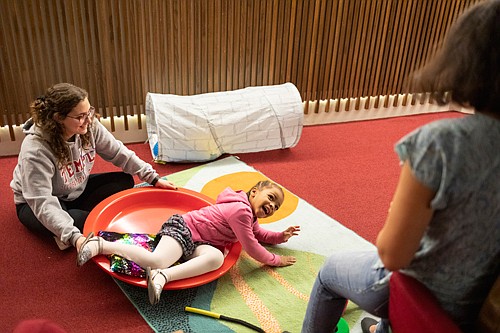Visitors at the Walters Art Museum are not only astonished by the museum’s stunning panorama of thousands of years of art, but they are also impressed by the museum’s continuous alliance with the autism community, as well as launching a virtual learning for kids at all ages during this time of uncertainty.
While the sensory program allows families of children with autism the opportunity to access and enjoy public spaces without worry, the virtual museum page is helping kids enlarge their circle of learning during quarantine.
It offers a number of digital resources such as coloring pages, lesson plans and manuscripts inspired by the museum art collection, where kids can dive into thousands of artworks from around the world and across centuries.
“We are trying to make the museum more accessible and welcoming place for everyone, we are providing a quiet space with sensory equipments and visual supports to provide families with more activities and to show parents that their kids are accepted as they are,” said Rebecca Sinel, a manager of the family program at the Walters Art Museum.
Brooke Shilling, 41, has a daughter with autism and is non-verbal. Shilling and her family have been attending Sensory Weekends at the Walters for 18 months.
“The program has fun crafts, manipulatives, sensory break and sensory play areas, and even provide social stories in advance so the kids know what to expect. The program is exceptional and our whole family loves it,” said Shilling.
Autism spectrum disorder (ASD) is a developmental disability, which causes significant social, communication and
behavioral challenges. According to the Center for Disease Control and Prevention, about one in 68 children are identified with autism spectrum disorder. This new estimate is roughly 30 percent higher than the previous estimate in 2012 where one in 88 children were identified with autism spectrum disorder. As the number of kids receiving a diagnoses of autism has been rising for years, the stigma around autism still run high as many families with kids with autism often face stereotype and misconception.
Lynn Canterbury, a director at the Forbush School at Glyndon, Maryland, which serves students with emotional disabilities and autism spectrum disorder, believes that stigma about autism was worse five or six years ago than it is now. She thinks that people are more accepting and understanding. Yet, she says that families’ lives and activities can be deeply affected by autism.
“It is difficult for some parents to take their kids in public, when the child is constantly scripting, screaming or flapping. Their normal everyday life and activities have to be adjusted,” said Canterbury. “Maybe if it’s a family of three they have said that one of the adult stayed home with the child with autism and the others go out, unless there is something so specific like programs at the Walters Art Museum where parents can take the entire family.”
Sinel says all the staff at the museum are welcoming and accepting to all families, especially the ones who are sometimes concerned about going to public places because of the perception about their kids behaviors; and how people will look at their kids; stare or yell at their kids; or ask them to leave.
“Through the sensory program, we are assuring families that this is not going to happen and hopefully they will have such a positive experience and come visit the Walters each and every time,” said Sinel.
The Center for Autism and Related Disorders (CARD) at the Kennedy Krieger Institute provides volunteers to facilitate activities at different stations alongside the Walters’ museum educators.
“CARD staff will support the museum educators by providing developmentally appropriate modifications, facilitating communication, and helping children engage with the materials and activities provided,” said Taylor Racicot, a Therapeutic Assistant at the Center For Autism and related Disorders at Kennedy Krieger Institute. “For a place like The Walters, an art gallery, with so many presumed rules about social behaviors, to say, ‘you are welcome here,’ and to back the sentiment up with physical supports is huge in the fight against the social stigma individuals with autism face.”
“The program offers special access to the museum, either before or after hours, and the support of Kennedy Krieger therapists. It is essentially free therapy with excellent therapists and supportive educators in a very special and serene environment,” said Shilling.
With the collaboration of Center for Autism and Related Disorders (CARD) at Kennedy Krieger, the sensory program at the Walters offers different intervention options and provides individualized treatment in small-group settings to children under age six. Children are given opportunities to work with new materials and practice their skills with new people. They even create works of art that are displayed in the Walters during sensory weekends.
“The Walters Sensory program helps to expanding the creative experiences children have and their access to the kinds of community engagement and experiences that neurotypical children have. The program also demonstrates to the larger community that individuals with autism are creative, innovative and deeply appreciative of art forms but they may just express that appreciation differently,” said Racicot.
Families continue attending and enjoying the sensory program at the Walters. Such events carry on with its mission to increase awareness and understanding and eventually fight social stigma that many families and kids with autism experience.
“I am grateful for the Walters program, it is a model of inclusion and should be replicated everywhere,” said Shilling.
